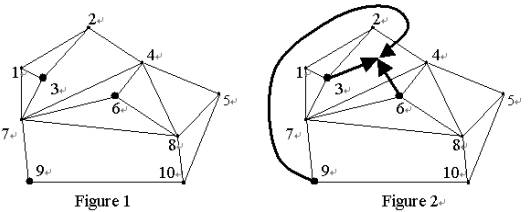POJ1161 Walls(Floyd+建图)
来源:互联网 发布:macbook pro 软件路径 编辑:程序博客网 时间:2024/05/21 22:42
题目链接:http://poj.org/problem?id=1161
Walls
Time Limit: 1000MS Memory Limit: 10000KTotal Submissions: 7386 Accepted: 3617
Description
In a country, great walls have been built in such a way that every great wall connects exactly two towns. The great walls do not cross each other. Thus, the country is divided into such regions that to move from one region to another, it is necessary to go through a town or cross a great wall. For any two towns A and B, there is at most one great wall with one end in A and the other in B, and further, it is possible to go from A to B by always walking in a town or along a great wall. The input format implies additional restrictions.
There is a club whose members live in the towns. In each town, there is only one member or there are no members at all. The members want to meet in one of the regions (outside of any town). The members travel riding their bicycles. They do not want to enter any towns, because of the traffic, and they want to cross as few great walls as possible, as it is a lot of trouble. To go to the meeting region, each member needs to cross a number (possibly 0) of great walls. They want to find such an optimal region that the sum of these numbers (crossing-sum, for short) is minimized.

The towns are labeled with integers from 1 to N, where N is the number of towns. In Figure 1, the labeled nodes represent the towns and the lines connecting the nodes represent the great walls. Suppose that there are three members, who live in towns 3, 6, and 9. Then, an optimal meeting region and respective routes for members are shown in Figure 2. The crossing-sum is 2: the member from town 9 has to cross the great wall between towns 2 and 4, and the member from town 6 has to cross the great wall between towns 4 and 7.
You are to write a program which, given the towns, the regions, and the club member home towns, computes the optimal region(s) and the minimal crossing-sum.
There is a club whose members live in the towns. In each town, there is only one member or there are no members at all. The members want to meet in one of the regions (outside of any town). The members travel riding their bicycles. They do not want to enter any towns, because of the traffic, and they want to cross as few great walls as possible, as it is a lot of trouble. To go to the meeting region, each member needs to cross a number (possibly 0) of great walls. They want to find such an optimal region that the sum of these numbers (crossing-sum, for short) is minimized.

The towns are labeled with integers from 1 to N, where N is the number of towns. In Figure 1, the labeled nodes represent the towns and the lines connecting the nodes represent the great walls. Suppose that there are three members, who live in towns 3, 6, and 9. Then, an optimal meeting region and respective routes for members are shown in Figure 2. The crossing-sum is 2: the member from town 9 has to cross the great wall between towns 2 and 4, and the member from town 6 has to cross the great wall between towns 4 and 7.
You are to write a program which, given the towns, the regions, and the club member home towns, computes the optimal region(s) and the minimal crossing-sum.
Input
Your program is to read from standard input. The first line contains one integer: the number of regions M, 2 <= M <= 200. The second line contains one integer: the number of towns N, 3 <= N <= 250. The third line contains one integer: the number of club members L, 1 <= L <= 30, L <= N. The fourth line contains L distinct integers in increasing order: the labels of the towns where the members live.
After that the input contains 2M lines so that there is a pair of lines for each region: the first two of the 2M lines describe the first region, the following two the second and so on. Of the pair, the first line shows the number of towns I on the border of that region. The second line of the pair contains I integers: the labels of these I towns in some order in which they can be passed when making a trip clockwise along the border of the region, with the following exception. The last region is the "outside region" surrounding all towns and other regions, and for it the order of the labels corresponds to a trip in counterclockwise direction. The order of the regions gives an integer labeling to the regions: the first region has label 1, the second has label 2, and so on. Note that the input includes all regions formed by the towns and great walls, including the "outside region".
After that the input contains 2M lines so that there is a pair of lines for each region: the first two of the 2M lines describe the first region, the following two the second and so on. Of the pair, the first line shows the number of towns I on the border of that region. The second line of the pair contains I integers: the labels of these I towns in some order in which they can be passed when making a trip clockwise along the border of the region, with the following exception. The last region is the "outside region" surrounding all towns and other regions, and for it the order of the labels corresponds to a trip in counterclockwise direction. The order of the regions gives an integer labeling to the regions: the first region has label 1, the second has label 2, and so on. Note that the input includes all regions formed by the towns and great walls, including the "outside region".
Output
Your program is to write to standard output. The first line contains one integer: the minimal crossing-sum.
Sample Input
101033 6 9 31 2 3 31 3 7 42 4 7 3 34 6 7 34 8 6 36 8 7 34 5 8 47 8 10 9 35 10 8 77 9 10 5 4 2 1
Sample Output
2
题意:一个地方,有用墙分成的m个区域,和n个城镇。现在有一个俱乐部,一个城镇中最多有一个成员。现在他们要聚会,问去哪个区域才能让所有成员穿过城墙的次数之和最少?
输入数据:
第一行为m,表示有m个区域。
第二行为n,表示有n个城镇。
接下来为l,表示俱乐部人数。
然后l个数,表示每个人分别在哪个城镇。
然后m组,每组描述一个区域。(包括最外面的区域)
第一行表示围成区域的点数,第二行逆时针顺序表示这几个点。
题目意思很明确,要求出穿墙次数最少,其实就是最短路。但这张图明显不是我们需要用到的图,所以要把它转化成以区域为点,墙为边的图,这也是这道题最麻烦的地方。
建图时顺便求出与俱乐部成员所在城镇相邻的区域。
转化完之后,先用Floyd求出多源最短路,然后对于每一个与俱乐部成员所在城镇相邻的区域,都求出到每个区域的最短路之和,在其中找出最短的数,即为所要求的答案。
#include <iostream>#include <cstdio>#include <cstring>#include <string>using namespace std;#define INF 0x3f3f3f3fint g[255][255];//建的图(区域为点)int m,n,l;int club[255];//俱乐部成员所在的城镇int marke[255][255];//表示i和j之间的边相邻的区域int adj[255][255];//表示j是否与城镇i相邻int main(){while (scanf("%d",&m)!=EOF){memset(g,0x3f,sizeof(g));scanf("%d",&n);scanf("%d",&l);for (int i=1;i<=l;i++){scanf("%d",&club[i]);}memset(marke,-1,sizeof(marke));memset(adj,0,sizeof(adj));for (int i=1;i<=m;i++){int x,tmp1,tmp2,tmp;scanf("%d",&x);scanf("%d",&tmp1);adj[tmp1][i]=1;//标记i与点tmp相邻tmp=tmp1;for (int j=1;j<x;j++){scanf("%d",&tmp2);adj[tmp2][i]=1;if (marke[tmp1][tmp2]==-1) {marke[tmp1][tmp2]=i;marke[tmp2][tmp1]=i;}//如果tmp1,tmp2没有相邻区域,则标为与i相邻else {g[marke[tmp1][tmp2]][i]=1;g[i][marke[tmp1][tmp2]]=1;marke[tmp2][tmp1]=i;}//如果有,则说明之前的区域与i区域相邻,建图tmp1=tmp2;}if (marke[tmp][tmp2]==-1) {marke[tmp][tmp2]=i;marke[tmp2][tmp]=i;}//注意首尾也是一条边else {g[marke[tmp][tmp2]][i]=1;g[i][marke[tmp][tmp2]]=1;marke[tmp2][tmp]=i;}}for (int i=1;i<=n;i++) g[i][i]=0;//开始Floyd算法for (int k=1;k<=m;k++){for (int i=1;i<=m;i++){for (int j=1;j<=m;j++){if (g[i][j]>g[i][k]+g[k][j]) g[i][j]=g[i][k]+g[k][j];}}}int ans=INF;for (int i=1;i<=m;i++){int sum=0;for (int j=1;j<=l;j++)//俱乐部情况{int mi=INF;for (int k=1;k<=m;k++)//找出从与俱乐部成员所在城镇相邻的哪个区域出发最少{if (adj[club[j]][k]==0) continue;//如果与俱乐部成员所在城镇不相邻则无视if (g[k][i]<mi) mi=g[k][i];//找出到区域i的最小值}sum+=mi;//俱乐部次数之和}if (sum<ans) ans=sum;//总的最少情况}printf("%d\n",ans);}return 0;} 0 0
- POJ1161 Walls(Floyd+建图)
- Walls(floyd POJ1161)
- poj1161 - Walls
- poj1161 walls floyd算法+把面当结点建图
- POJ 1161 Walls(建图+Floyd)
- POJ1161 几何+floyd+枚举
- POJ 1161 WALLS (FLOYD)
- poj1161 floyd+把面当做节点
- POJ 1161 Walls(floyd最短路)#by zh
- poj1161
- poj 1161 Walls floyd算法
- [POJ 1161] Walls 建图
- HDU1348-Walls(经典凸包)
- sgu 174 Walls (并查集)
- POJ 1161 Walls(二分图匹配)
- codeforces MUH and Cube Walls (kmp)
- poj1161 The Suspects
- poj1161 The Suspects
- 图片解析
- php进制转换
- 运行和学习高通提供的一些例子
- No WebApplicationContext found: no ContextLoaderListener registered?
- 自动点击屏幕-调用android隐藏的功能
- POJ1161 Walls(Floyd+建图)
- android Intent传递 object , list<object>,list<Map<String,Object>>
- 使用Ganglia对hadoop进行监控
- ZOJ 3432 Find the Lost Sock
- ubuntu下安装RabbitVCS
- 切换Wifi网络快速获取wifi的ssid
- win下硬盘安装ubuntu【转载】
- Java Map接口
- ubuntu12.04.4安装smartsvn


